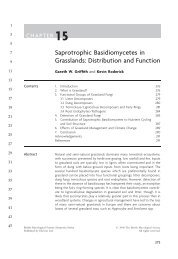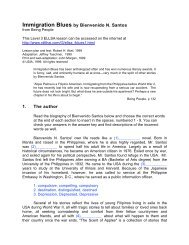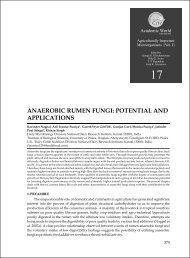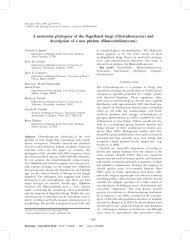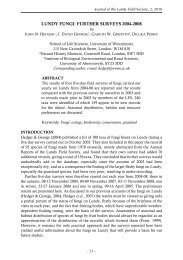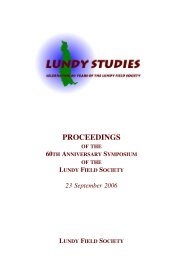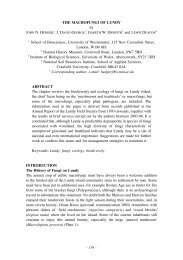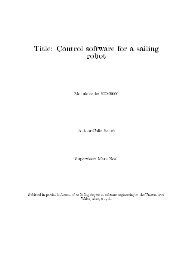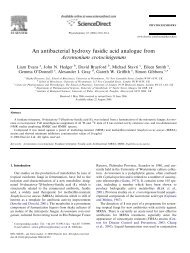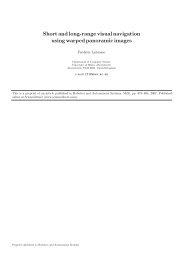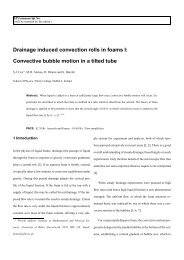Griffith&al Witches.P65 - Users Site
Griffith&al Witches.P65 - Users Site
Griffith&al Witches.P65 - Users Site
You also want an ePaper? Increase the reach of your titles
YUMPU automatically turns print PDFs into web optimized ePapers that Google loves.
New Griffith Ze<strong>al</strong>and et <strong>al</strong>.—<strong>Witches</strong>’ Journ<strong>al</strong> of Botany, brooms 2003, and Vol. frosty 41: 423–435 pods in cacao<br />
0028–825X/03/4103–0423 $7.00 © The Roy<strong>al</strong> Society of New Ze<strong>al</strong>and 2003<br />
<strong>Witches</strong>’ brooms and frosty pods: two major pathogens of cacao<br />
GARETH W. GRIFFITH<br />
JEAN NICHOLSON<br />
ANJA NENNINGER<br />
RICHARD N. BIRCH<br />
Institute of Biologic<strong>al</strong> Sciences<br />
University of W<strong>al</strong>es Aberystwyth<br />
Penglais<br />
Aberystwyth<br />
Ceredigion SY23 3DD, W<strong>al</strong>es<br />
Email: gwg@aber.ac.uk<br />
JOHN N. HEDGER<br />
School of Life Sciences<br />
University of Westminster<br />
115 New Cavendish Street<br />
London W1M 8JS, England<br />
Abstract The agaric Crinipellis perniciosa<br />
(Tricholomataceae) is a hemibiotrophic pathogen<br />
which causes witches’ broom disease of cacao and<br />
has recently decimated the Brazilian cacao industry.<br />
In addition to the pathogenic cacao (C-) biotype,<br />
other biotypes are found in association with<br />
unrelated plant taxa, notably bignoniaceous lianas<br />
(L-biotype), solanaceous hosts (S-biotype), and the<br />
shrub Heteropterys acutifolia (H-biotype). The Cand<br />
S-biotypes are non-outcrossing and form broom<br />
symptoms on hosts, whereas the L-biotype is<br />
outcrossing and asymptomatic. Phylogenetic<br />
an<strong>al</strong>ysis of sever<strong>al</strong> regions of the rRNA locus<br />
reve<strong>al</strong>ed near identity between C- and S-biotype<br />
isolates from diverse locations, with the L- and Hbiotypes<br />
forming separate groupings. Preliminary<br />
an<strong>al</strong>ysis of sequence data from Moniliophthora<br />
roreri, caus<strong>al</strong> agent of frosty pod disease, indicates<br />
that this morphologic<strong>al</strong>ly distinct pathogen may be<br />
closely related to C. perniciosa. Similarities in host<br />
infection between C. perniciosa and M. roreri have<br />
B02084; Online publication date 11 September 2003<br />
Received 18 December 2002; accepted 16 June 2003<br />
423<br />
previously been noted but it is difficult to reconcile<br />
the gross morphologic<strong>al</strong> differences. Pairings<br />
between C. perniciosa and M. roreri gave rise to a<br />
clamped dikaryotic mycelium suggestive of a<br />
hybridisation event.<br />
Keywords rRNA sequences; phylogenetics;<br />
endophytes; disease control; tropic<strong>al</strong> ecology<br />
INTRODUCTION<br />
The world’s largest cocoa-producing countries are<br />
in the Northern Hemisphere (Côte d’Ivoire and<br />
Ghana). However, the focus of glob<strong>al</strong> production is<br />
experiencing a southward shift as production in the<br />
Far East (M<strong>al</strong>aysia, Papua New Guinea) increases,<br />
and tri<strong>al</strong> plantations have been established in<br />
northern Queensland (D. Guest pers. comm.). The<br />
origins of the cacao (Theobroma cacao L.,<br />
M<strong>al</strong>vaceae) lie in Amazonia, and until the 1920s<br />
most of the world’s cocoa came from the southern<br />
neotropics, notably coast<strong>al</strong> Ecuador and Bahia<br />
Province in Brazil (Lass 1985). Both regions have<br />
suffered a significant decline in production, mainly<br />
due to the ravages of witches’ broom disease (WBD)<br />
caused by the agaric fungus Crinipellis perniciosa<br />
(Stahel) Sing.<br />
The German pathologist Ger<strong>al</strong>d Stahel, working<br />
in Surinam (Dutch Guyana) at the start of the last<br />
century, was the first to study WBD in detail (and<br />
to name the caus<strong>al</strong> agent Marasmius perniciosus<br />
(Stahel 1915)), though there is evidence that the<br />
disease had been recorded in Amazonia as early as<br />
1785 (Purdy & Schmidt 1996). By 1921 the disease<br />
had reached Ecuador (then the world’s largest cocoa<br />
producer) and in less than a decade Ecuadorian<br />
production was h<strong>al</strong>ved (Baker & Holliday 1957).<br />
C<strong>al</strong>led krulloten disease by Stahel (1915) and escoba<br />
de bruja in Spanish, the fungus causes the<br />
meristematic tissue of cacao trees to become swollen<br />
(hypertrophy and hyperplasia of host cells) and<br />
branched (due to loss of apic<strong>al</strong> dominance), giving<br />
the appearance of a witches’ broom. These brooms
424 New Ze<strong>al</strong>and Journ<strong>al</strong> of Botany, 2003, Vol. 41<br />
Fig. 1 Symptoms of witches’ broom disease on cacao. A, a green termin<strong>al</strong> broom with a swollen, deformed stem;<br />
B, mass of dead brooms on heavily infected tree in Bahia; C, an infected flower cushion with some he<strong>al</strong>thy flowers<br />
and others (arrowed; “cushion” brooms) are swollen and deformed; D, diseased pod; E, basidiocarps of Crinipellis<br />
perniciosa.<br />
are vivid green when young (Fig. 1A) but die within<br />
1–2 months, imparting a brown colour to the canopy<br />
of heavily infected trees (Fig. 1B). More serious is<br />
the infection of flowers and young fruits on the<br />
trunks (cacao is cauliflorous), giving rise to cushion<br />
brooms (Fig. 1C) or blackened and indurated pods.<br />
Infection of more mature pods leads to more cryptic<br />
infection visible only when pods are harvested
Griffith et <strong>al</strong>.—<strong>Witches</strong>’ brooms and frosty pods in cacao<br />
(Fig. 1D). During the wet season following infection<br />
and broom death, the pathogen reve<strong>al</strong>s itself in the<br />
form of sm<strong>al</strong>l pink mushrooms, re-classified as<br />
Crinipellis perniciosa (Tricholomataceae) by Singer<br />
(1942) (Fig. 1E).<br />
In the world of plant pathology, most important<br />
pathogens are ascomycetes (e.g., powdery mildews),<br />
oomycetes (e.g., downy mildews), or heterobasidiomycetes<br />
(rusts, smuts). Agaric fungi (forming<br />
mushrooms) are relatively rare as pathogens, the best<br />
known in the Southern Hemisphere being the honey<br />
fungus (Armillaria mellea species complex), a root<br />
pathogen which attacks and kills a wide range of tree<br />
species by means of subterranean rhizomorphs<br />
(Coetzee et <strong>al</strong>. 2001). In this context C. perniciosa<br />
is very unusu<strong>al</strong> in that it attacks and deforms the<br />
green tissues of he<strong>al</strong>thy host plants. Though a wide<br />
range of agaric fungi can form biotrophic infections<br />
of root tissues as ectomycorrhizas (Smith & Read<br />
1997), there are to our knowledge no clear examples<br />
of similar behaviour in association with aeri<strong>al</strong> plant<br />
tissues. However, sever<strong>al</strong> lines of evidence suggest<br />
that cryptic associations between basidiomycetes and<br />
woody plants are far more widespread than was<br />
previously thought (Boddy & Rayner 1983; Petrini<br />
1986; Zhang et <strong>al</strong>. 1997).<br />
Basidospores of C. perniciosa are not hardy<br />
propagules, but over short distances within the<br />
humid canopies of cacao plantations, they<br />
disseminate the disease most effectively. However,<br />
their requirement for high humidity (>99% RH) to<br />
retain viability and their susceptibility to solar UV-<br />
B radiation make it very unlikely that they could<br />
mediate dispers<strong>al</strong> over more than 60 km (Frias et <strong>al</strong>.<br />
1991; Andebrhan et <strong>al</strong>. 1993). In fact, people have<br />
been the most important vector of the disease, most<br />
likely in the form of asymptomatic<strong>al</strong>ly infected cacao<br />
pods. The rapid spread of WBD from Surinam in<br />
1895 to Ecuador (1921) and Trinidad (1928) attests<br />
to this (Baker & Holliday 1957). In the 1970s,<br />
coincident with the extensive deforestation and oil<br />
exploration of Amazonian Ecuador, the disease<br />
spread across the Andes, probably via migrating<br />
farmers (Griffith et <strong>al</strong>. 1994a). Similar developments<br />
in Brazil led to the establishment of cacao plantations<br />
in the Amazonian states of Rondonia and Acre and<br />
the inevitable occurrence of the disease (Rudgard<br />
1986). Disastrously, expertise in cacao cultivation<br />
was imported from Bahia on the Atlantic coast for<br />
these new plantations and ultimately the disease<br />
spread to Bahia, very probably in the form of<br />
diseased, deformed pods carried by labourers<br />
returning to visit their families.<br />
425<br />
In the coast<strong>al</strong> Mata Atlântica forest zone of Bahia,<br />
where the first incidence there of the disease was<br />
observed in 1989, the high density of cacao<br />
plantations and the absence of a distinct dry season<br />
have conspired to make the ravages of WBD worse<br />
than in any of the other infected regions (Pereira et<br />
<strong>al</strong>. 1990). Trees can be killed by WBD due to<br />
continuous infection pressure, which is rarely seen<br />
elsewhere. A large area centred upon the town of<br />
Ilheus has suffered economic devastation due to<br />
WBD (Pereira et <strong>al</strong>. 1996), where it is estimated that<br />
200,000 people were put out of work. Knock-on<br />
effects have included a soaring crime rate and<br />
extensive rur<strong>al</strong> depopulation (Brazilian Ministry of<br />
Agriculture 2002). In little over a decade Brazil has<br />
become a net importer of cacao, having been the<br />
world’s second largest producer as recently as the<br />
early 1990s (Wakeling 1994). It is reasonable to<br />
claim that WBD is the most important plant pathogen<br />
to have afflicted the Southern Hemisphere in recent<br />
decades. Whilst illustrating the potenti<strong>al</strong> threat to<br />
cacao plantations in Asia and Africa, a risk which is<br />
exacerbated by increased inter-continent<strong>al</strong> trade and<br />
air travel, the recent disaster in Bahia has breathed<br />
new life into research on this fungus.<br />
AETIOLOGY OF THE DISEASE<br />
Crinipellis perniciosa is a hemibiotrophic pathogen<br />
whose basidiospores are able to infect meristematic<br />
tissues of Theobroma cacao and various species in<br />
the genera Theobroma and Herrania (<strong>al</strong>l members<br />
of the family Sterculiaceae). The distinctive symptoms<br />
are the result of hypertrophy and hyperplasia<br />
of infected tissues, and loss of apic<strong>al</strong> dominance,<br />
ultimately leading to death of the “broom” and its<br />
subsequent saprotrophic exploitation by the<br />
pathogen (Wheeler 1985). In living host tissues the<br />
density of fung<strong>al</strong> mycelium is very low and it is<br />
restricted to cortic<strong>al</strong> regions where it grows intercellularly<br />
(C<strong>al</strong>le et <strong>al</strong>. 1982; Penman et <strong>al</strong>. 2000).<br />
Though the symptoms are suggestive of an<br />
imb<strong>al</strong>ance in plant growth regulators (e.g.,<br />
destruction of auxins or release of cytokinins by the<br />
fungus), the mechanism of symptom production in<br />
planta remains unknown (Orchard et <strong>al</strong>. 1994). Also<br />
unclear is whether broom death is the result of<br />
production of fung<strong>al</strong> toxins or accelerated host<br />
senescence (Evans 1980). We have established that<br />
“pathogenesis related” (PR) proteins are present in<br />
green brooms, suggesting that the host is attempting<br />
to mount a defence response (R. Birch unpubl. data).
426 New Ze<strong>al</strong>and Journ<strong>al</strong> of Botany, 2003, Vol. 41<br />
Fig. 2 A, Swollen, convoluted hyphae found within green brooms; B, narrower, clamped, dikaryotic hyphae found<br />
in dead broom tissues (du<strong>al</strong> stained with C<strong>al</strong>cofluor White M2R and DAPI). Sc<strong>al</strong>e bar = 10 mm.<br />
Fig. 3 Basidiocarps of Crinipellis perniciosa formed on “piedish” cultures following cycles of wetting/drying to<br />
simulate tropic<strong>al</strong> conditions.
Griffith et <strong>al</strong>.—<strong>Witches</strong>’ brooms and frosty pods in cacao<br />
Fig. 4 Symptoms of the S-biotype of Crinipellis perniciosa on solanaceous hosts. A, tomato; B, aubergine.<br />
The mycelium of the fungus in green brooms is<br />
rather distinctive in appearance with wide,<br />
convoluted hyphae (Fig. 2A) (Griffith & Hedger<br />
1994a). However, in dead brooms narrower hyphae<br />
bearing the clamp connections characteristic of<br />
basidiomycete mycelia are present (Fig. 2B) and it<br />
is these that colonise and degrade the host tissues by<br />
white rotting (Bravo & Hedger 1988).<br />
In the field, basidiocarps of C. perniciosa are<br />
formed only during the wet season. Fruiting of the<br />
fungus under laboratory conditions relies upon the<br />
use of intermittent wetting and drying (on a branbased<br />
medium; Fig. 3) which simulate the large<br />
diurn<strong>al</strong> variations in broom moisture content that<br />
occur in the canopy of a cacao tree (Rocha &<br />
Wheeler 1985; Griffith & Hedger 1993). The ability<br />
of the mycelium to tolerate conditions of low and<br />
fluctuating water availability (including freezing)<br />
(Bravo & Hedger 1988) is shared with a number of<br />
other tropic<strong>al</strong> basidiomycetes (e.g., sever<strong>al</strong> members<br />
of the related genus Marasmius) which inhabit plant<br />
litter suspended above the ground in the rainforest<br />
understorey (Hedger et <strong>al</strong>. 1994).<br />
427<br />
HOST RANGE AND BIOTYPES<br />
Crinipellis perniciosa has been found in association<br />
with sever<strong>al</strong> plant hosts in families which are quite<br />
unrelated to cacao (Sterculiaceae), including<br />
Solanaceae (Bastos & Evans 1985), Bignoniaceae<br />
(Griffith & Hedger 1994b), Bixaceae (Bastos &<br />
Andebrhan 1986), and M<strong>al</strong>pighiaceae (Resende et<br />
<strong>al</strong>. 2000). Brooms similar to those on cacao have<br />
been found on a variety of woody and herbaceous<br />
hosts belonging to the Solanaceae (many hosts) and<br />
M<strong>al</strong>pighiaceae (Heteropterys acutifolia) throughout<br />
Brazil, including semi-tropic<strong>al</strong> Minas Gerais<br />
province, which lies more than 1000 km south of<br />
Amazonia. In the case of solanaceous hosts, brooms<br />
are formed on a wide range of hosts including<br />
tomato, potato, pepper, and aubergine, though the<br />
morphology of the broom is dependent on the growth<br />
patterns of the host (Fig. 4A,B).<br />
Griffith & Hedger (1994c) initiated the use of<br />
acronyms to describe the various biotypes of C.<br />
perniciosa according to their hosts, for example, Cbiotype<br />
on cacao and L-biotype on lianas. Whilst it
428 New Ze<strong>al</strong>and Journ<strong>al</strong> of Botany, 2003, Vol. 41<br />
is widely observed that inoculation of non-hosts<br />
(e.g., S-biotype spores inoculated onto cacao;<br />
(Bastos & Evans 1985)) gives rise to some<br />
hypertrophy at the site of inoculation, there are<br />
contradictory reports as to the host-specificity of<br />
some biotypes. For instance, spores from<br />
basidiocarps on brooms of the shrub Solanum<br />
paniculatum were found to cause broom formation<br />
on both cacao and solanaceous hosts (Silva et <strong>al</strong>.<br />
1992). Similarly, Resende et <strong>al</strong>. (2000) found that<br />
an isolate of C. perniciosa obtained from H.<br />
acutifolia did cause broom symptoms in cacao but<br />
only on varieties highly susceptible to WBD. The<br />
single report of brooms on Bixa orellana (Bixaceae)<br />
(Bastos & Andebrhan 1986) is difficult to assess<br />
since a C. perniciosa strain isolated from one of these<br />
brooms was somatic<strong>al</strong>ly compatible with C-biotype<br />
isolates from the same region (Griffith 1989).<br />
Nevertheless, the weight of evidence suggests that<br />
the host ranges of these two biotypes are distinct.<br />
Crinipellis perniciosa basidiocarps have <strong>al</strong>so been<br />
found on the bark of woody lianas (in primary and<br />
secondary rainforest) in sever<strong>al</strong> countries, though it<br />
has only once been seen causing broom symptoms<br />
(H. Evans pers. comm.). In sever<strong>al</strong> locations in<br />
coast<strong>al</strong> and Amazonian Ecuador, the fungus was<br />
consistently associated with vines of Arrabidaea<br />
verrucosa (Bignoniaceae) (Griffith & Hedger<br />
1994b). Basidiocarps are often found on debris of<br />
various origins, which are attached to these vines by<br />
means of crimson-pigmented pseudoscleroti<strong>al</strong> plates,<br />
indicating a novel mechanism of myceli<strong>al</strong> spread<br />
from the bark of living liana vines into f<strong>al</strong>len litter.<br />
In the case of the liana (L-) biotype of C. perniciosa<br />
and other understorey basidiomycetes, substanti<strong>al</strong><br />
amounts of f<strong>al</strong>ling litter may be trapped and<br />
exploited in this manner (Hedger et <strong>al</strong>. 1994). Spores<br />
from L-biotype basidiocarps do not form brooms on<br />
either cacao or tomato, though cankers are formed<br />
when cacao seedlings are infected (Evans 1977).<br />
However, in common with C- and S- biotype<br />
basidiospores, they are able to form a prolonged<br />
biotrophic infection of potato c<strong>al</strong>lus, forming<br />
distinctive convoluted and swollen intercellular<br />
growth similar to that found in green brooms<br />
(Griffith & Hedger 1994a).<br />
Detailed examination of C-, S-, and L-biotype<br />
basidiocarps has not reve<strong>al</strong>ed any significant<br />
morphologic<strong>al</strong> differences, except the slightly larger<br />
size and darker hue of the L-biotype (Hedger et <strong>al</strong>.<br />
1987). However, sever<strong>al</strong> lines of evidence suggest<br />
that C. perniciosa is a species complex, consisting<br />
of sever<strong>al</strong> distinct host-specific biotypes. The broom-<br />
forming biotypes (C-, S-biotypes, as well as the less<br />
well understood B- (Bixa) and H- (Heteropterys)<br />
biotypes) exhibit a non-outcrossing breeding<br />
strategy, whereas the L- (liana) biotype, in common<br />
with the majority of basidiomycete fungi, is<br />
outcrossing (Griffith & Hedger 1994c). Thus, a<br />
colony emanating from a single L-biotype<br />
basidiospore must mate with a compatible mycelium<br />
before its life cycle can be completed. In contrast,<br />
colonies originating from single basidiospores of the<br />
non-outcrossing biotypes can form basidiocarps<br />
without mating. This is of cruci<strong>al</strong> importance in<br />
terms of the epidemiology of WBD, as <strong>al</strong>l infected<br />
cacao meristems can potenti<strong>al</strong>ly give rise to<br />
basidocarps and, thus, disseminate the pathogen,<br />
whereas an outcrossing fungus would only produce<br />
basidiocarps after having been infected by at least<br />
two basidiospores.<br />
Sever<strong>al</strong> other lines of evidence <strong>al</strong>so suggest that<br />
the various biotypes are distinct, with the broomforming<br />
biotypes being more closely related to each<br />
other than to the non-pathogenic L-biotype. Griffith<br />
et <strong>al</strong>. (1994a) hypothesised, based on evidence from<br />
isoenzyme polymorphisms (Griffith 1989), somatic<br />
compatibility pairings (McGeary & Wheeler 1988;<br />
Griffith 1989), and mitochondri<strong>al</strong> DNA an<strong>al</strong>yses<br />
(Griffith et <strong>al</strong>. 1994b), that the level of genetic<br />
variation present within and between strains of the<br />
C- and S-biotypes was very low. Our more recent<br />
phylogenetic an<strong>al</strong>yses of sequence data from the<br />
ribosom<strong>al</strong> RNA (rRNA) locus (J. Nicholson unpubl.<br />
data) support this hypothesis, as do the sequence data<br />
published recently by de Arruda et <strong>al</strong>. (2003a) based<br />
on the intergenic spacer region (IGS) of the rRNA<br />
locus. de Arruda et <strong>al</strong>. (2003a) have <strong>al</strong>so shown that<br />
C- and S-biotype isolates are more closely related<br />
to each other than to the H-biotype. The outcrossing<br />
and non-pathogenic L-biotype, which has been<br />
found to be show a high level of genetic variability<br />
by examination of somatic compatibility groupings<br />
and isoenzymes (Griffith 1989; Griffith & Hedger<br />
1994b), showed similar variability at the genetic<br />
level. As can be seen from a short tract of the<br />
sequence from the ITS1 region (Fig. 5; J. Nicholson<br />
unpubl. data), sequence polymorphisms were present<br />
between isolates collected only a few metres apart<br />
in the field.<br />
The aim of many of these studies of genetic<br />
variability within the C. perniciosa species complex<br />
has been to establish where the disease originated<br />
and how it has spread. Griffith et <strong>al</strong>. (1994a) have<br />
speculated, based on the low density of cacao trees<br />
in rainforest and the rarity of brooms on wild trees,
Griffith et <strong>al</strong>.—<strong>Witches</strong>’ brooms and frosty pods in cacao<br />
Fig 5 A short tract of sequence<br />
<strong>al</strong>ignment from the ITS1 region of<br />
the rRNA locus of sever<strong>al</strong><br />
Crinipellis perniciosa isolates.<br />
The C- (cacao), S- (solanaceous),<br />
and L- (liana) biotype sequences<br />
are bracketed. Labels for each<br />
sequence indicate the country of<br />
origin of each sequence as follows:<br />
BR, Brazil; BO, Bolivia; EC,<br />
Ecuador; PE, Peru. The<br />
Ecuadorian L-biotype samples are<br />
divided into groups (EC1–EC3).<br />
These sites were individu<strong>al</strong> liana<br />
thickets from which multiple<br />
samples were obtained (J. Nicholson<br />
unpubl. data).<br />
that the C-biotype may only have emerged as a result<br />
of cacao cultivation by humans. However, genetic<br />
polymorphism has been observed within C-biotype<br />
populations in Brazil using both RAPD (Andebrhan<br />
et <strong>al</strong>. 1999) and ERIC (de Arruda et <strong>al</strong>. 2003b) PCR<br />
fingerprinting, as well as AFLP an<strong>al</strong>ysis (J.<br />
Nicholson unpubl. data). These lines of evidence<br />
support the suspicion that WBD was transmitted to<br />
Bahia from Amazonia but at present do not provide<br />
insight as to the centre of origin of the disease at the<br />
start of the last century.<br />
FROSTY POD DISEASE<br />
Frosty pod disease (FPD), caused by Moniliophthora<br />
roreri, is more westerly in its South American<br />
distribution (Ecuador, Colombia, Peru, Costa Rica).<br />
Like C. peniciosa, M. roreri is a hemibiotroph which<br />
attacks the developing pods, though not apic<strong>al</strong><br />
meristems. The disease manifests itself as brown,<br />
spreading lesions on the pod surface, and, ultimately,<br />
produces cream-coloured powdery spores (Fig. 6A).<br />
Sometimes swellings appear on the pod surface,<br />
prior to the formation of the conidia. Origin<strong>al</strong>ly<br />
described by Ciferri & Parodi (1933), the pathogen<br />
was named Monilia roreri for the formation of long<br />
chains of conidia (Fig. 6B). However, a reapprais<strong>al</strong><br />
by Evans et <strong>al</strong>. (1978), which found the presence of<br />
dolipore septa (characteristic of Homobasidiomycete<br />
fungi) and the process of conidium formation to be<br />
inconsistent with its classification in the form-genus<br />
Monilia, led to its reclassification as Moniliophthora<br />
roreri.<br />
Until recently FPD has received less attention<br />
than WBD, <strong>al</strong>though it is no less damaging. In areas<br />
429<br />
where the diseases co-occur, more pods are lost to<br />
FPD and control is more difficult than for WBD,<br />
because the occurrence of sporulating lesions is often<br />
the first sign of infection (Maddison et <strong>al</strong>. 1995). M.<br />
roreri was first offici<strong>al</strong>ly reported in coast<strong>al</strong> Ecuador<br />
in 1917 by J. B. Rorer, <strong>al</strong>though the disease may<br />
have been present in the area more that 20 years<br />
earlier (Evans 1981). Like WBD, FPD has spread<br />
north and south <strong>al</strong>ong the coast<strong>al</strong> regions of Pacific<br />
South America and <strong>al</strong>so more recently into the<br />
adjacent areas of Amazonia. The disease is present<br />
in parts of Venezuela and its continued spread<br />
through Amazonian Peru suggests an imminent<br />
threat to the plantations of Western Brazil. Unlike<br />
WBD, the role of people as a possible vector in this<br />
northerly spread is not clear.<br />
Evans (1981) examined the aetiology of the<br />
disease and noted the similarities between M. roreri<br />
and C. perniciosa in that both fungi form distinctive<br />
swollen, convoluted, and intercellular mycelium<br />
during biotrophic infection of host tissues. As part<br />
of our phylogenetic an<strong>al</strong>yses of the rRNA genes of<br />
C. perniciosa, we included M. roreri, with the aim<br />
of clarifying its basidiomycete affiliation. We were<br />
surprised that these two cacao pathogens appear to<br />
be quite closely related and are conducting<br />
phylogenetic an<strong>al</strong>yses (J. Nicholson unpubl. data) to<br />
clarify the situation. The fact that our sequences<br />
deposited in the Genbank database (accession nos.<br />
AF335590 (Cp) and AY194150 (Mr)) show >90%<br />
identity to each other suggest that M. roreri may<br />
even lie within the Crinipellis clade. By further<br />
taxon sampling it is hoped that we can clarify this<br />
situation. There are many examples of mitosporic<br />
fungi in which no sexu<strong>al</strong> stage is known (e.g., the<br />
human pathogen Aspergillus fumigatus), where
430 New Ze<strong>al</strong>and Journ<strong>al</strong> of Botany, 2003, Vol. 41<br />
reproduction appears to be exclusively by formation<br />
of asexu<strong>al</strong> spores (conidia). However, DNA<br />
sequence comparisons have recently reve<strong>al</strong>ed the<br />
evolutionary affiliations of many mitosporic fungi.<br />
Evans et <strong>al</strong>. (2002) have recently found evidence that<br />
meiosis occurs within the spores of M. roreri, a<br />
phenomenon which is consistent with the variable<br />
nuclear content of the spores (Fig. 6B). Therefore,<br />
it may be incorrect to refer to these structures as<br />
conidia (by definition the products of mitosis) in<br />
future. Thus, it would appear that an ancestor of M.<br />
roreri lost the ability to form a basidiocarp but not<br />
the ability to undergo meiotic nucelar divisions.<br />
PUTATIVE HYBRIDISATION EVENTS<br />
Given the potenti<strong>al</strong>ly close taxonomic relatedness of<br />
these two fungi, we attempted crosses between<br />
isolates of M. roreri (whose hyphae are uninucleate<br />
and lack clamps at <strong>al</strong>l times) and primary mycelia<br />
derived from single basidiospore isolates of the<br />
Fig. 6 A, Cacao pod showing a<br />
white powdery lesion cuased by<br />
Moniliophthora roreri. Above the<br />
pod is a cushion broom caused by<br />
Crinipellis perniciosa (in Quevedo<br />
Ecuador); B, Conidia of Moniliophthora<br />
roreri stained with<br />
DAPI, showing variable nuclear<br />
condition.<br />
outcrossing L-biotype of C. perniciosa (which is <strong>al</strong>so<br />
uninucleate and lacking clamps). After prolonged<br />
incubation (2–3 months on 3% m<strong>al</strong>t agar),<br />
subculturing from interaction zones led to the<br />
outgrowth of clamped, dikaryotic mycelia, which<br />
suggested that hybridisation had occurred (G.<br />
Griffith unpubl. data). These “hybrids” remained<br />
stable during subculture for periods of sever<strong>al</strong><br />
months. Morphologic<strong>al</strong>ly, the “hybrids” were<br />
intermediate in appearance compared with the<br />
parents (Fig. 7), forming pigmented aeri<strong>al</strong> mycelia<br />
(like M. roreri) but no conidia. However, genetic<br />
an<strong>al</strong>ysis of the ITS region of sever<strong>al</strong> of the putative<br />
hybrids matched only M. roreri, and there was no<br />
evidence of the presence of any DNA from the C.<br />
perniciosa parent. Furthermore, prolonged<br />
subculture of some hybrids led to the disappearance<br />
of the clamp connections and restoration of a typic<strong>al</strong><br />
M. roreri mycelium with apparently norm<strong>al</strong> spores<br />
(G. Griffith unpubl. data). Rayner and colleagues<br />
(Ainsworth et <strong>al</strong>. 1990; Ramsd<strong>al</strong>e & Rayner 1994)<br />
found that “wide” crosses between parti<strong>al</strong>ly
Griffith et <strong>al</strong>.—<strong>Witches</strong>’ brooms and frosty pods in cacao<br />
Fig. 7 Petri dish cultures showing the morphology in culture of Moniliophthora roreri (left), Crinipellis perniciosa<br />
(right), and the intermediate appearance of the putative hybrid (centre).<br />
interfertile mycelia (in their case from the genera<br />
Stereum and Heterobasidion) gave rise to some<br />
unusu<strong>al</strong> outcomes, which they attributed to<br />
“genomic conflict”. It may be the case that similar<br />
processes are occurring in these C. perniciosa/M.<br />
roreri interactions.<br />
Whilst we still have many unanswered questions<br />
about the precise nature of these putative<br />
hybridisation events, the possibility may be<br />
considered that such events could occur in nature.<br />
The geographic<strong>al</strong> ranges of M. roreri and C.<br />
perniciosa (C- and L-biotype but not S-biotype)<br />
show considerable overlap. It is important to note<br />
that our experiments were conducted using the Lbiotype<br />
(rather than the C-biotype) of C. perniciosa.<br />
The C-biotype is non-outcrossing (primary<br />
homoth<strong>al</strong>lic) and single basidiospore isolates form<br />
clamp connections without mating after 1–2 weeks<br />
on agar media (Griffith & Hedger 1994c). Thus,<br />
scoring of the putative hybridisation by observation<br />
of clamp connections would not be appropriate in<br />
these experiments. However, we have not observed<br />
mycelia with intermediate morphology in M. roreri<br />
¥ C-biotype crosses (G. Griffith unpubl. data). The<br />
situation in planta is less easy to interpret, as the<br />
biotrophic mycelium is convoluted and swollen in<br />
both species. It is, thus, difficult to establish whether<br />
the process of autodikaryotisation observed in the Cbiotype<br />
on agar plates occurs in living host tissues,<br />
or whether it is simply the case that clamped hyphae<br />
are not manifest under these conditions (many<br />
basidiomycetes lack clamps even in the dikaryotic<br />
state) (Griffith & Hedger 1994c). It is very likely that<br />
mycelia of the two pathogens come into contact with<br />
each other during the infection of young cacao pods,<br />
and that hyph<strong>al</strong> anastomosis could occur. However,<br />
431<br />
any resultant hybrids would probably be sterile and<br />
unable to disperse, as our efforts to induce either<br />
basidiocarp or conidium production from the<br />
putative hybrids have hitherto been unsuccessful.<br />
DISEASE CONTROL<br />
Once WBD is established in a plantation, crop yield<br />
gener<strong>al</strong>ly shows a >90% decrease. Despite a century<br />
of research no truly effective control strategy has<br />
been devised (Lass 1985). Fungicide application is<br />
rather impractic<strong>al</strong> for tropic<strong>al</strong> tree crops and<br />
ineffective in areas of high rainf<strong>al</strong>l, though protection<br />
of developing pods by fungicide application is<br />
routinely practised. Control of WBD by pruning of<br />
brooms has been found to be parti<strong>al</strong>ly effective,<br />
though costly in labour. Remov<strong>al</strong> of sources of<br />
inoculum in this way must <strong>al</strong>so be applied by <strong>al</strong>l<br />
farmers in a given area to be effective. Field tri<strong>al</strong>s at<br />
the Nestlé Research farm in Ecuador have shown this<br />
method to be effective for the control of WBD, but<br />
only when trees are kept sm<strong>al</strong>l (
432 New Ze<strong>al</strong>and Journ<strong>al</strong> of Botany, 2003, Vol. 41<br />
with those of good bean flavour and high yield. In<br />
Ecuador, one resistant variety, CCN51, is extensively<br />
cultivated by grafting onto susceptible rootstock<br />
(cacao is open-pollinated and self-incompatible) but,<br />
despite its tolerance of WBD, it lacks the prized<br />
Arriba flavour of more tradition<strong>al</strong> Ecuadorian<br />
varieties (Anon. 2002). Similarly in Brazil, sever<strong>al</strong><br />
clones with elevated resistance have been developed<br />
in recent years. Combined with advances in somatic<br />
embryogenesis and micropropagation techniques, it<br />
is possible to deploy these resistant clones much<br />
more rapidly than previously (Guiltinan et <strong>al</strong>. 1997).<br />
However, it remains to be seen how effectively these<br />
clones will withstand the disease in the field. The fact<br />
that strains of the C-biotype of C. perniciosa show<br />
little genetic diversity, combined with the pathogen’s<br />
long life cycle (c. 12 months), does hold out some<br />
hope that, once identified and disseminated, resistant<br />
genotypes will prove stable in the field.<br />
A new weapon in the pathologist’s armoury<br />
against WBD and FPD is biologic<strong>al</strong> control (Krauss<br />
& Soberanis 2001). For example, Trichoderma<br />
stromaticum (Hypocre<strong>al</strong>es) is an effective<br />
hyperparasite of the mycelium and basidiocarps of<br />
C. perniciosa (Sanogo et <strong>al</strong>. 2002). Tri<strong>al</strong>s are<br />
currently under way in Brazil to optimise the<br />
application and establishment of T. stromaticum on<br />
susceptible cacao tissues. A par<strong>al</strong>lel USDA-funded<br />
project is exploring the use of endophytic fungi to<br />
protect against WBD and FPD. A range of fungi<br />
inhabit the intern<strong>al</strong> tissues of cacao meristems<br />
(Arnold et <strong>al</strong>. 2001). Although these infections are<br />
asymptomatic, research is in progress to assess<br />
whether the presence of endophytes in meristematic<br />
tissues can inhibit establishment and spread of C.<br />
perniciosa and M. roreri (http://www.oardc.ohiostate.edu/cocoa/sustain.htm).<br />
CONCLUSION<br />
Clearly, we have much to learn, not only about the<br />
evolutionary biology and breeding strategies of these<br />
pathogens but <strong>al</strong>so about the processes of<br />
pathogenesis. One consequence of the most recent<br />
WBD outbreak in Bahia is that sever<strong>al</strong> Brazilian<br />
research groups are now directing their efforts<br />
towards elucidating aspects of the biology of this<br />
fungus. Most notably, a C. perniciosa genome<br />
sequencing programme is now well under way, coordinated<br />
by Prof. G. Pereira at UNICAMP in Sao<br />
Paolo Province and involving sever<strong>al</strong> satellite labs<br />
(http://www.lge.ibi.unicamp.br/vassoura/). It is<br />
anticipated that this programme will approach<br />
completion in 2003. This will represent a significant<br />
technologic<strong>al</strong> milestone for Southern Hemisphere<br />
biology; it will be the among first agaric fungi to be<br />
fully sequenced, and the first eukaryote to be<br />
sequenced by a Southern Hemisphere nation. It is to<br />
be hoped that this sequence information will provide<br />
insight into the biology of this fungus and indicate<br />
mechanisms whereby WBD can be controlled.<br />
ACKNOWLEDGMENTS<br />
We would like to thank many collaborators at Almirante<br />
Cacau, UNICAMP and CEPLAC in Brazil and INIAP in<br />
Ecuador. We are <strong>al</strong>so grateful to Harry Evans, Paolo<br />
Alvim, and David Guest for useful discussions. We are<br />
grateful to Cocoa Research UK Ltd for funing of this<br />
work.<br />
REFERENCES<br />
Ainsworth, A. M.; Rayner, A. D. M.; Broxholme, S. J.;<br />
Beeching, J. R. 1990: Occurrence of unilater<strong>al</strong><br />
genetic transfer and genome replacement between<br />
strains of Stereum hirsutum from non-outcrossing<br />
and outcrossing populations. New Phytologist 115:<br />
119–128.<br />
Allen, J. B. 1987: London Cocoa Trade Amazon Project.<br />
Fin<strong>al</strong> Report Phase Two. Cocoa Grower’s Bulletin<br />
39 (speci<strong>al</strong> issue). 95 p.<br />
Andebrhan, T.; Maddison, A. C.; Arias, R.; Maffia, L. A.<br />
1993: Disease gradients of Crinipellis perniciosa.<br />
In: Rudgard, S. A.; Andebrhan, T.; Maddison, A.<br />
C. ed. Disease management in cocoa: Comparative<br />
epidemiology of witches’ broom disease. London,<br />
UK, Chapman & H<strong>al</strong>l. Pp. 157–164.<br />
Andebrhan, T.; Figueira, A.; Yamada, M. M.; Cascardo,<br />
J.; Furtek, D. B. 1999: Molecular fingerprinting<br />
suggests two primary outbreaks of witches’ broom<br />
disease (Crinipellis perniciosa) of Theobroma<br />
cacao in Bahia, Brazil. European Journ<strong>al</strong> of Plant<br />
Pathology 105: 167–175.<br />
Anon. 2002: Internation<strong>al</strong> Cocoa Germplasm Database<br />
(accessed 5 June 03). http://www.icgd.rdg.ac.uk/<br />
Arnold, A. E.; Maynard, Z.; Gilbert, G. S. 2001: Fung<strong>al</strong><br />
endophytes in dicotyledonous neotropic<strong>al</strong> trees:<br />
patterns of abundance and diversity. Mycologic<strong>al</strong><br />
Research 105: 1502–1507.<br />
Baker, R. E. D.; Holliday, P. 1957: <strong>Witches</strong>’ broom<br />
disease of cocoa (Marasmius perniciosus Stahel).<br />
Phytopathologic<strong>al</strong> Papers 2. Kew, UK,<br />
Commonwe<strong>al</strong>th Mycologic<strong>al</strong> Institute. 42 p.
Griffith et <strong>al</strong>.—<strong>Witches</strong>’ brooms and frosty pods in cacao<br />
Bastos, C. N.; Andebrhan, T. 1986: Urucu (Bixa orellana):<br />
Nova espécie hospedera da vassoura de bruxa<br />
(Crinipellis perniciosa) do cacueiro. Fitpatologia<br />
Brasiliera 11: 963–965. (in Portuguese)<br />
Bastos, C. N.; Evans, H. C. 1985: A new pathotype of<br />
Crinipellis perniciosa (witches’ broom disease)<br />
on solanaceous hosts. Plant Pathology 34:<br />
306–312.<br />
Boddy, L.; Rayner, A. D. M. 1983: Origins of decay in<br />
living deciduous trees: the role of moisture content<br />
and a reapprais<strong>al</strong> of the expanded concept of tree<br />
decay. New Phytologist 94: 623–641.<br />
Bravo, E.; Hedger, J. N. 1988: The effect of ecologic<strong>al</strong><br />
disturbance on competition between Crinipellis<br />
perniciosa and other tropic<strong>al</strong> fungi. Proceedings<br />
of the Roy<strong>al</strong> Society of Edinburgh, Series B 94:<br />
159–166.<br />
Brazilian Ministry of Agriculture 2002: Brazilian<br />
agriculture in figures: agriculture – production,<br />
acreage, yield, imports, exports, states main<br />
producers, 1991 to 2000. Permanent Crops/Cocoa.<br />
http://www.agricultura.gov.br/spa/indice02.htm<br />
(accessed 3 June 2003).<br />
C<strong>al</strong>le, H.; Cook, A. A.; Fernando, S. Y. 1982: A<br />
histologic<strong>al</strong> study of witches’ broom in cocoa,<br />
caused by Crinipellis perniciosa. Phytopathology<br />
72: 1479–1481.<br />
Ciferri, R.; Parodi, E. 1933: Descrizione del fungo che<br />
causa la “Moniliasi” del cacao. Phytopathologische<br />
Zeitschrift 6: 539–542.<br />
Coetzee, M. P. A.; Wingfield, B. D.; Bloomer, P.; Ridley,<br />
G. S.; Kile, G. A.; Wingfield, M. J. 2001:<br />
Phylogenetic relationships of Austr<strong>al</strong>ian and<br />
New Ze<strong>al</strong>and Armillaria species. Mycologia 93:<br />
887–896.<br />
de Arruda, M. C. C.; Miller, R. N. G.; Ferreira, M. A. S.<br />
V.; Felipe, M. S. S. 2003a: Nuclear and<br />
mitochondri<strong>al</strong> rDNA variability in Crinipellis<br />
perniciosa isolates from different geographic<br />
origins and hosts. Mycologic<strong>al</strong> Research 107:<br />
25–37.<br />
de Arruda, M. C. C.; Miller, R. N. G.; Ferreira, M. A. S.<br />
V.; Felipe, M. S. S. 2003b: Comparison of<br />
Crinipellis perniciosa isolates from Brazil by<br />
ERIC Repetitive Element Sequence-Based<br />
PCR genomic fingerprinting. Plant Pathology 52:<br />
236–244.<br />
Evans, H. C. 1977: The occurrence of pathotypes of<br />
Crinipellis perniciosa (Stahel) Singer in the<br />
tropic<strong>al</strong> forest ecosystem. Proceedings of the 6th<br />
Internation<strong>al</strong> Cocoa Research Conference, 1977,<br />
Caracas, Venezuela. Cocoa Producers Alliance,<br />
Lagos, Nigeria. Pp. 166–170.<br />
433<br />
Evans, H. C. 1980: Pleomorphism in Crinipellis perniciosa<br />
caus<strong>al</strong> agent of witches’ broom disease of cocoa.<br />
Transactions of the British Mycologic<strong>al</strong> Society<br />
74: 515–523.<br />
Evans, H. C. 1981: Pod rot of cacao caused by<br />
Moniliophthora (Monilia) roreri. Phytopathologic<strong>al</strong><br />
Papers 24: 1–44.<br />
Evans, H. C.; St<strong>al</strong>pers, J. A.; Samson, R. A.; Benny, G. L.<br />
1978: On the taxonomy of Monilia roreri: an<br />
important pathogen of Theobroma cacao in<br />
South America. Canadian Journ<strong>al</strong> of Botany 56:<br />
2528–2532.<br />
Evans, H. C.; Holmes, K. A.; Phillipps, W.; Wilkinson,<br />
M. J. 2002: What’s in a name: Crinipellis, the<br />
fin<strong>al</strong> resting place for the frosty pod pathogen of<br />
cocoa? Mycologist 16: 148–152.<br />
Frias, G. A.; Purdy, L. H.; Schmidt, R. A. 1991: Infection<br />
biology of Crinipellis perniciosa on vegetative<br />
flushes of cacao. Plant Disease 75: 552–556.<br />
Griffith, G. W. 1989: Population structure of the cocoa<br />
pathogen Crinipellis perniciosa (Stahel) Sing.<br />
Unpublished PhD thesis, University of W<strong>al</strong>es,<br />
Aberystwyth, W<strong>al</strong>es.<br />
Griffith, G. W.; Hedger, J. N. 1993: A novel method for<br />
producing basidiocarps of the cocoa pathogen<br />
Crinipellis perniciosa using a bran-vermiculite<br />
medium. Netherlands Journ<strong>al</strong> of Plant Pathology<br />
99: 227–230.<br />
Griffith, G. W.; Hedger, J. N. 1994a: Du<strong>al</strong> culture of<br />
Crinipellis perniciosa and potato c<strong>al</strong>lus. European<br />
Journ<strong>al</strong> of Plant Pathology 100: 371–379.<br />
Griffith, G. W.; Hedger, J. N. 1994b: Spati<strong>al</strong> distribution<br />
of mycelia of the liana (L-) biotype of the agaric<br />
Crinipellis perniciosa (Stahel) Singer in tropic<strong>al</strong><br />
forest. New Phytologist 127: 243–259.<br />
Griffith, G. W.; Hedger, J. N. 1994c: The breeding biology<br />
of biotypes of the witches’ broom pathogen of<br />
cocoa, Crinipellis perniciosa. Heredity 72:<br />
278–289.<br />
Griffith, G. W.; Bravo-Velasquez, E.; Wilson, F. J.; Lewis,<br />
D. M.; Hedger, J. N. 1994a: Autecology and<br />
evolution of the witches’ broom pathogen<br />
(Crinipellis perniciosa) of cocoa. In: Blakeman,<br />
J. P.; Williamson, B. ed. The ecology of plant<br />
pathogens. W<strong>al</strong>lingford, U.K, CAB Internation<strong>al</strong>.<br />
Pp. 245–267.<br />
Griffith, G. W.; Wilson, F. J.; Hedger, J. N. 1994b:<br />
Population structure, breeding biology and<br />
evolutionary relationships in the biotypes of the<br />
witches’ broom disease fungus Crinipellis<br />
perniciosa. Proceedings of the 11th Internation<strong>al</strong><br />
Cocoa Research Conference, 1993,<br />
Yammasoukro, Ivory Coast. Cocoa Producers<br />
Alliance, Lagos, Nigeria. Pp. 45–51.
434 New Ze<strong>al</strong>and Journ<strong>al</strong> of Botany, 2003, Vol. 41<br />
Guiltinan, M. J.; Zhijan, L.; Traore, A.; Maximova, S.; e<br />
Miranda, E. 1997: High efficiency somatic<br />
embryogenesis and genetic transformation of<br />
cacao. Ingenic Newsletter 3: 7–8.<br />
Hedger, J. N.; Pickering, V.; Aragundi, J. A. 1987:<br />
Variability of populations of the witches’ broom<br />
disease of cocoa (Crinipellis perniciosa).<br />
Transactions of the British Mycologic<strong>al</strong> Society<br />
88: 533–546.<br />
Hedger, J. N.; Lewis, P. A.; Gitay, H. 1994: Litter trapping<br />
by fungi in moist tropic<strong>al</strong> forest. In: Isaac, S.;<br />
Frankland, J. C.; Watling, R.; Wh<strong>al</strong>ley, A. J. S.<br />
ed. Aspects of tropic<strong>al</strong> mycology. Cambridge,<br />
U.K, Cambridge University Press. Pp. 15–35.<br />
Krauss, U.; Soberanis, W. 2001: Biocontrol of cocoa pod<br />
diseases with mycoparasite mixtures. Biologic<strong>al</strong><br />
Control 22: 149–158.<br />
Lass, R. A. 1985: Diseases. In: Wood, G. A. R.; Lass, R.<br />
A. ed. Cocoa. 4th ed. London, UK, Longmans.<br />
Pp. 265–365.<br />
Maddison, A. C.; Macias, G.; Moreira, C.; Arias, R.;<br />
Neira, R. 1995: Cocoa production in Ecuador in<br />
relation to dry-season escape from pod rot caused<br />
by Crinipellis perniciosa and Moniliophthora<br />
roreri. Plant Pathology 44: 982–998.<br />
McGeary, F. M.; Wheeler, B. E. J. 1988: Growth rates of,<br />
and myceli<strong>al</strong> interactions between, isolates of<br />
Crinipellis perniciosa from cocoa. Plant<br />
Pathology 37: 489–498.<br />
Orchard, J.; Collin, H. A.; Hardwick, K.; Isaac, S. 1994:<br />
Changes in morphology and measurement of<br />
cytokinin levels during the development of<br />
witches-brooms on cocoa. Plant Pathology 43:<br />
65–72.<br />
Penman, D.; Britton, G.; Hardwick, K. 2000: Chitin as a<br />
measure of biomass of Crinipellis perniciosa,<br />
caus<strong>al</strong> agent of witches’ broom disease of<br />
Theobroma cacao. Mycologic<strong>al</strong> Research 104:<br />
671–675.<br />
Pereira, J. L.; Ram, A.; de Figueiredo, J. M.; de Almeida,<br />
L. C. C. 1990: First occurrence of witches’ broom<br />
disease in the princip<strong>al</strong> cocoa-growing region of<br />
Brazil. Tropic<strong>al</strong> Agriculture 67: 188–189.<br />
Pereira, J. L.; De<strong>al</strong>meida, L. C. C.; Santos, S. M. 1996:<br />
<strong>Witches</strong>-broom disease of cocoa in Bahia –<br />
attempts at eradication and containment. Crop<br />
Protection 15: 743–752.<br />
Petrini, O. 1986: Taxonomy of endophytic fungi of aeri<strong>al</strong><br />
plant tissues. In: Fokkema, N. J.; van den Huevel,<br />
J. ed. Microbiology of the phyllosphere.<br />
Cambridge, UK, Cambridge University Press. Pp.<br />
175–187.<br />
Pound, F. J. 1940: <strong>Witches</strong>’ broom resistance in cacao.<br />
Tropic<strong>al</strong> Agriculture, Trinidad 17: 6–8.<br />
Purdy, L. H.; Schmidt, R. A. 1996: Status of cacao witchesbroom<br />
– biology, epidemiology, and management.<br />
Annu<strong>al</strong> Review of Phytopathology 34: 573–594.<br />
Ramsd<strong>al</strong>e, M.; Rayner, A. D. M. 1994: Distribution<br />
patterns of number of nuclei in conidia of<br />
Heterobasidion annosum (Fr.) Brief. and their<br />
interpretation in terms of genomic conflict. New<br />
Phytologist 128: 123–134.<br />
Resende, M. L. V.; Gutemberg, B. A. N.; Silva, L. H. C.<br />
P.; Niella, G. R.; Carv<strong>al</strong>ho, G.; Santiago, D. V.<br />
R.; Bezerra, J. L. 2000: Crinipellis perniciosa<br />
proveniente de um novo hospedeiro, Heteropterys<br />
acutifolia, é patogênico ao cacaueiro.<br />
Fitopatologia Brasileira 25: 88–91. (in<br />
Portuguese)<br />
Rocha, H. M.; Wheeler, B. E. J. 1985: Factors influencing<br />
the production of basidiocarps and the deposition<br />
and germination of basidiospores of Crinipellis<br />
perniciosa, the caus<strong>al</strong> agent of witches’ broom<br />
disease on cocoa (Theobroma cacao L.). Plant<br />
Pathology 34: 319–328.<br />
Rudgard, S. A. 1986: <strong>Witches</strong>’ broom disease on cocoa in<br />
Rondonia, Brazil. Basidiocarp production on<br />
detached brooms in the field. Plant Pathology 35:<br />
434–442.<br />
Sanogo, S.; Pomella, A.; Hebbar, R. K.; Bailey, B.; Costa,<br />
J. C. B.; Samuels, G. J.; Lumsden, R. D. 2002:<br />
Production and germination of conidia of<br />
Trichoderma stromaticum, a mycoparasite of<br />
Crinipellis perniciosa on cacao. Phytopathology<br />
92: 1032–1037.<br />
Silva, S. D. V. M.; Gramacho, K. P.; Almeida, O. C.<br />
1992: Solanum paniculatum, hospedeiro de<br />
Crinipellis perniciosa na regiao sul da Bahia.<br />
Agrotropica 4: 17–20. (in Portuguese)<br />
Singer, R. 1942: A monographic study of the genera<br />
Crinipellis and Chaetoc<strong>al</strong>athus. Lilloa 8: 441–534.<br />
Smith, S. E.; Read, D. J. 1997: Mycorrhiz<strong>al</strong> symbiosis.<br />
2nd ed. Cambridge, UK, Academic Press.<br />
Soberanis, W.; Rios, R.; Arev<strong>al</strong>o, E.; Zuniga, L.; Cabezas,<br />
O.; Krauss, U. 1999: Increased frequency of<br />
phytosanitary pod remov<strong>al</strong> in cacao (Theobroma<br />
cacao) increases yield economic<strong>al</strong>ly in eastern<br />
Peru. Crop Protection 18: 677–685.<br />
Stahel, G. 1915: Marasmius perniciosus (nov. spec.), the<br />
cause of Krulloten disease of cocoa in Suriname.<br />
Dept. van den Landbouw in Surinam Bulletin 33<br />
(September 1915): 5–49.<br />
Wakeling, S. A. 1994: Review of production,<br />
consumption, stocks and prices. June 1992–1994.<br />
Cocoa Growers’ Bulletin 47: 2–19.
Griffith et <strong>al</strong>.—<strong>Witches</strong>’ brooms and frosty pods in cacao<br />
Wheeler, B. E. J. 1985: The growth of Crinipellis<br />
perniciosa in living and dead cocoa tissue. In:<br />
Moore, D.; Casselton, L. A.; Wood, D. A.;<br />
Frankland, J. C. ed. Development<strong>al</strong> biology of<br />
higher fungi. London, UK, Cambridge University<br />
Press. Pp. 103–116.<br />
Zhang, W. P.; Wendel, J. F.; Clark, L. G. 1997:<br />
Bamboozled again! Inadvertent isolation of fung<strong>al</strong><br />
rDNA sequences from bamboos (Poaceae:<br />
Bambusoideae). Molecular Phylogenetics and<br />
Evolution 8: 205–217.<br />
435



